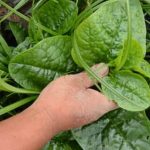Introduction
Growing your own food is a fantastic way to become self-sustainable and provide yourself with fresh and nutritious produce. Plus, people can improve their quality of life by being closer to nature. Having a front yard vegetable garden is a great way to achieve these benefits while still taking up minimal amounts of space.
A front yard veggie garden provides many advantages compared to other types of gardens. For one, it’s an easy and cost-effective way to get started in the world of gardening because you use the land right outside your door! Furthermore, controlling pests and access to water is more accessible due its close proximity. With the added benefit of improving the appearance of one’s property, it’s also a great conversation starter as people will naturally be intrigued when they walk or drive past your house.
Besides that, having a front yard veggie garden can help lower food costs because store bought produce is usually expensive. Additionally, home-grown vegetables are far fresher than those from stores because you eat them soon after harvesting. Most vegetables can grow easily in containers or pots on decks or patios, freeing up the open ground for other ornamental plants or trees. Plus, home grown veggies are free from chemical fertilizers that industrial farms use, making them organically produced and safer to consume.
In short, growing your own food can be quite rewarding and starting a vegetable garden near your house offers several benefits that make it an ideal option for anyone looking to eat healthy food while increasing self-sufficiency skills. To get started in creating this vegetable oasis, there are few key things one should consider before getting their hands dirty!
Preparing the Site
Starting a front yard vegetable garden is a rewarding and fun project. Preparing the site for planting is an important step that shouldn’t be overlooked in order to ensure a successful harvest. First, analyze your space – it should have to have good drainage, since waterlogged soil can suffocate plants’ roots. Tip: use natural debris such as pebbles and stones on the bottom of the plot if your soil has poor drainage properties. Considerations like access to ample sunlight and protection from excessive shade or wind must also be taken into account when planning your plot of land.
Sunlight requirements will differ greatly depending on the variety of vegetables you hope to plant. Most leafy green vegetables require anywhere between 4-8 hours of direct sunlight, while root vegetables tend to thrive under warmer temperatures; thus requiring more hours of direct sunlight than their leafy counterparts – up to 8-12 hours, depending on the crop’s specific needs. Also consider any existing trees that may block beneficial sunlight or provide resistance from windy conditions since overly exposed plants can lead to concentration of soils salts and eventual wilting due to heat stress.
In addition to selecting an optimal sun/shade ratio for your garden plot, it is important to test the pH levels, nutrients and other components of your soil with a simple home kit prior to planting day for best results. Make sure you also familiarize yourself with what types of vegetables do well in different soils – some may require extra fertilization or attention that others don’t need as much and be aware these extra steps should be taken before germination occurs and not just at planting time! Finally, keep a watchful eye on weeds that could harm the development so regular maintenance practices are necessary throughout growing season or seasonal changes.
Planning Your Garden
Before starting a front yard vegetable garden, it is important to do adequate research and planning beforehand. This includes researching what type of vegetables can be planted in your climate, and the best times of year for planting them. Additionally, critical decisions must be made regarding which varieties should be planted: disease-resistant varieties that require less maintenance or heirloom varieties that will produce unique flavors with greater care needs? Additionally, research should be done on how to care for and maintain the vegetables; this includes proper watering, weeding, pest control, harvesting techniques and soil amendments. It is also important to consider where to locate the garden in order to maximize sunlight exposure and provide the shortest path between the kitchen and the garden for easy harvest access. All of these considerations are necessary for successful garden planning.
Planting Your Garden
When starting your front yard vegetable garden, it is important to have the right tools available for the job. Essential tools should include a spade, a trowel, a rake, and scissors. Other helpful tools may include forks, hoes, and cultivators to help create soil beds with paths in between them.
When choosing what vegetables you will be growing in your front yard garden there are few guidelines to keep in mind: Plant vegetables that are suited for your region’s climate, choose vegetables that suit your family’s tastes, grow vegetables you and your family can enjoy eating fresh or cooked and plan to use succession planting so that you continually harvest fresh veggies throughout the growing season.
Once you have chosen what vegetables you plan on growing and have properly prepared the soil with fertilizer and compost it is time to start planting! For optimal results practice “interplanting” which is when two different crops are planted close together such as putting spinach around peppers or garlic alongside tomatoes. Interplanting not only helps maximize the space but can also benefit both plants as long as they bloom at different times of year. Additionally “companion planting” can provide many benefits by pairing similar plants together such as onions and beets or squash next to nasturtiums which wards off harmful pests. Doing this will provide an environment where all crops can thrive simultaneously resulting in higher yields of certain veggies!
Maintenance of the Garden
Managing the nutrients of your vegetable garden is a vital part of its success. Fertilizer provides the essential elements (nitrogen, phosphorus, and potassium) your vegetables need to grow and thrive. Choose a slow-release fertilizer that provides balanced nutrition and is easy on the environment. You should apply it before you plant your garden, but also throughout the growing season in order to maintain vitality.
Compost is another key component to a successful front yard vegetable garden. Compost adds organic matter, beneficial microbial activity and even more nutrients for healthy growth. You can purchase compost or create your own from yard waste or kitchen scraps, which can be added directly to the soil or used as mulch around plants.
Weed and insect control are both important aspects of maintaining your front yard vegetable garden. Selecting organic favored methods will help keep the surrounding ecology undisturbed while efficiently mitigating pests. There are many options to choose from such as beneficial insects, companion planting and hand removal.
Finally, proper watering practices will ensure optimal plant health in your vegetable garden. Water deeply at least 1-2 times per week giving each plant a thorough soaking to reach roots deeper within the soil profile, reducing runoff and decreasing evaporation losses. Adjust water frequency according to temperature fluctuations if needed.
Harvesting the Garden
Harvesting a vegetable garden can be a fun and rewarding experience. It is important to always monitor your crops in order to ensure the highest quality of produce. The first step to harvesting vegetables is checking for maturity; vegetables should be harvested only when they reach their peak flavor and size. Immature vegetables will not taste as good, so it’s important to pay attention and harvest only when it’s ready.
Different types of vegetables require different methods for harvesting them. Leafy greens such as lettuce and spinach are typically harvested by cutting off the outer leaves, leaving the inner leaves intact for future harvests. Root crops such as potatoes, carrots, radishes, and turnips need to be pulled from the ground. For vine crops such as tomatoes, squash and cucumbers, you should pick fruits when they change color or feel ripe to the touch. Once picked make sure not to bruise them while handling them in order to preserve its shelf life.
Storing and preserving your vegetable harvest will allow you to enjoy it year round. Vegetables can either be stored fresh in cool temperatures or preserved through freezing, canning, or drying. Freshly-harvested veggies will last longest if kept out of direct sunlight and humid conditions until they are prepared; similarly frozen goods should remain frozen until use to prevent freezer burn, which decreases quality over time. With all preservation methods there are special guidelines that need to be followed for best results; specific recipes may depend on how acidic the vegetable is as well as on the concentration of sugar or salt used in the process (both act as preservatives).
Finally, consider techniques you can use to prolong your harvest season just a little longer before cold weather sets in like: cover planting with cloches (frost protection covers), covering cold sensitive plants with blankets during little frost events at night or growing heat loving summer crops alongside your winter plants during late summer or early fall months for an autumn harvest.
Enjoying the Garden
Starting a front yard vegetable garden can be a very rewarding experience. Not only will you have fresh, homegrown produce to eat, but you also get to enjoy the beauty of your garden and reap the benefits of home gardening.
To get started, begin with proper soil preparation. Begin by testing your soil’s pH levels and nutrient content to determine which type of soil amendment or fertilizer you should use. Once your soil has been properly prepared, it is time to create raised beds for your vegetables or treat individual planting areas with the appropriate amendments.
Now that your garden area is ready, it’s time to start planning out your vegetable varieties! Think about companion planting and crop rotation when selecting which kinds of fruits and vegetables you’d like to grow in your garden. Choose selections based on each season as some plants may not do well year-round. Additionally, draw up a design for what you want your garden space to look like before moving ahead with planting.
Once all tasks are complete, it’s time to sit back and enjoy reaping the rewards! Enjoy the delicious joys of eating produce harvested straight from home. Try out new recipes featuring homegrown ingredients such as late-summer ratatouille or roasted winter squash. Also take advantage of DIY projects that will enhance the aesthetics of your garden like water features or creative trellises for climbing crops such as tomatoes or cucumbers. Lastly, join in on community gardening events such as harvest festivals or potluck meals where multiple local gardens come together to share their stories and tips while enjoying delicious food made with homegrown produce!

If you’re looking to get into vegetable gardening, or are just looking for some tips on how to make your current garden better, then you’ve come to the right place! My name is Ethel and I have been gardening for years. In this blog, I’m going to share with you some of my best tips on how to create a successful vegetable garden.





